Knife Information
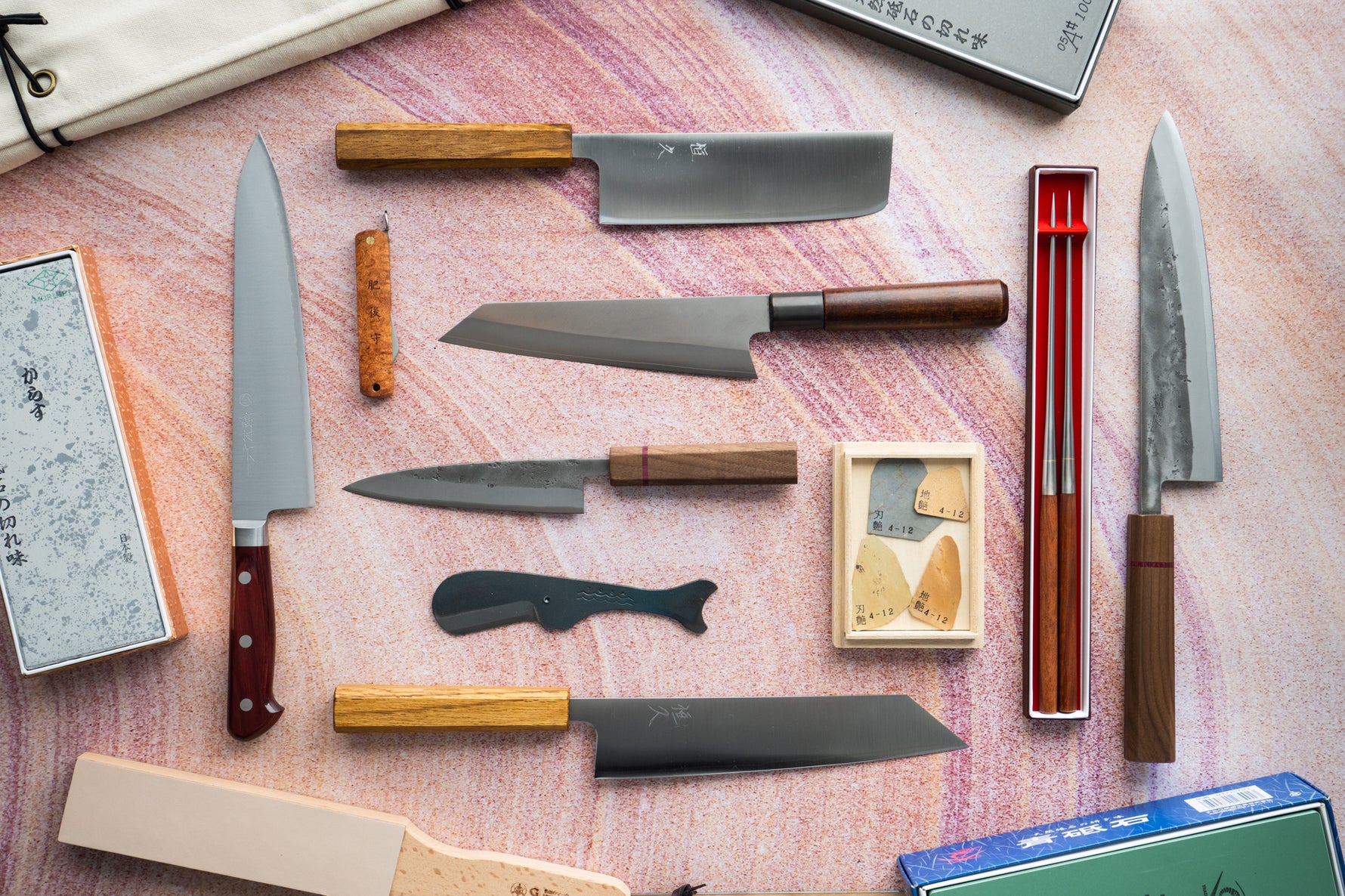
Gifting A Japanese Knife - Making the right choice
Which Japanese knife makes the best gift?
Whether it’s a special birthday or an anniversary gift, a fine Japanese knife is a cut above and will be sure to impress. For that person in your life who is an aspiring foodie, loves cooking or would like to take their skills to the next level, a Japanese knife makes an excellent gift for the person who has everything. With everyone spending more time at home, it’s time to take those cooking talents to the next level, and with our range of knives available in Australia, it’s never been easier to find the perfect gift. If you’re new to Japanese knives, a few easy questions can help you decide the perfect gift. The best way to consider what knife suits best is to think about how the lucky recipient will be using it.
For the barbeque lover - Sujihiki
Does your partner love to show off their skills with the American roaster or Tomahawk steaks? Do they like to roll out slabs of beef and flash their knife in the air as they prepare for a hungry crowd? Is there a touch of the theatre in the way they wield their blade? Consider the Okeya Ginsun Sujihiki. This beautiful blade is handcrafted by a father and son team in Miki City Hyogo and features a long blade made with Ginsan, a high carbon stainless steel. With all the benefits of a Carbon Steel without the extra maintenance or worry about rust. The understated elegance of the handle is enhanced by the fine Kanji etched on the blade. It’s a serious blade and it’s seriously lovely to look at.
For the everyday go-to knife – Santoku
For someone that loves to cook but mainly sticks to smaller meat and veg, the Santoku is the perfect introduction to Japanese knives. Try the Tadafusa Seido Santoku. Based on a carbon steel cutting edge but clad in stainless up the side of the blade, it’s easier to maintain than some other carbon steel knives due to the stainless cladding. In a sleek black box, this Octagon handled piece with a Nashiji or “Pear Skin” style finish is a looker and sure to impress.
For the fisherman – Deba
The fish markets are their happy place – they love to wander comparing the different offerings and choosing just the right cuts to create their masterpieces. Whether they’re trying to impress you or a whole crowd of friends, they like to delight with their skills and mastery. The best option here is the Deba knife – perfect for fish filleting. With a single edged blade, it is a specialty knife for filleting and removing the heads from fish, rather than general purpose cutting. Try the Ishikawa Blue 2 Deba 180 MM. The maker of this knife puts his emphasis on performance, not appearance, but you wouldn’t know this from looking at this spectacular understated blade. Sometimes a whisper says more than a shout.
For the allrounder – Bunka
They watch MasterChef and Iron Chef and call out the contestants for bad technique. They are most happy taking on food challenges in their own home. They believe you should only have one kitchen knife…and that knife should be an amazing allrounder. Buy them the Kanjo HAP40 Bunka and watch them clap their hands with glee at the stunning polished blade with dimple hammer-marks from the blacksmith, and a lightweight, waterproof handle made from timber and resin.
For the faster vegetable chopper in the house – Nakiri
Just because you’re chopping vegetables or whipping up a vegan feast doesn’t mean you can’t have superior performance and a blade to match. They love to show off their knife skills with a “who me? I’m just here cutting up veggies” flourish, as they whirl the whole produce section of their cutting board into a wok. One great suggestion is the Shiro Kamo Shirogami 2 Damascus Nakiri. This is a pure carbon steel knife, and is recommended for those that love their chef knives and don’t mind the extra maintenance. Shirogami is a pure carbon steel with no stainless elements, so be sure to keep that blade dry immediately after use and watch that beautiful blue and purple patina develop on the blade. Featuring the stylish octagonal blade in sexy black walnut, and a delightfully thin grind, the aspiring chef will enjoy slicing and dicing like they’re demonstrating on a cooking show. Why should the meat-eaters be the only ones to get the great knives?
Buy your loved one a Japanese knife today
So there you have it, some great ideas for a special someone who richly deserves it. The best part of giving a knife is that each of these Japanese knives has a rich history and culture that goes with them and will become heirlooms over time. They are truly a gift that will get a lot of use and will stand the test of time. Of course, you don’t have to give them away – you could always find one for yourself on this list. Order today from Chefs Edge.
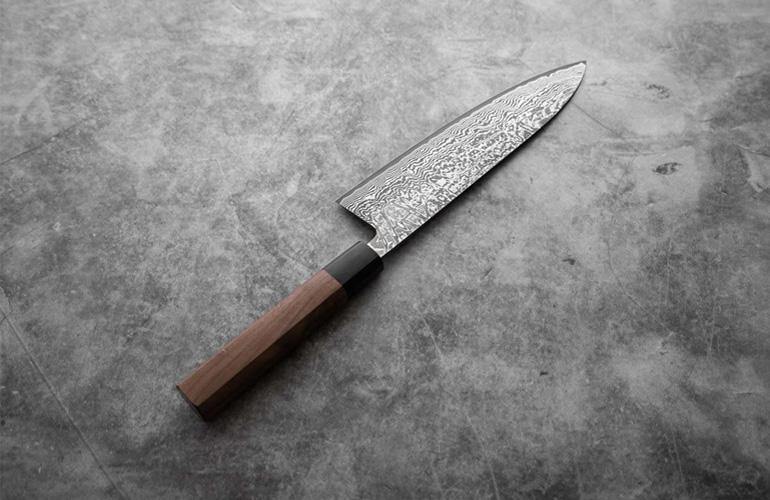
Japanese Chef Knives - The Gyuto
When we talk about Japanese chef knives, the one you may be most familiar with is the Gyuto. Let’s dive into the origins and history of this tool, and the different ways you might use this world renowned chefs tool.
What Exactly Is It?
The Gyuto is the Japanese version of the western chef’s knife and is very versatile — it can be used for everything from chopping vegetables to slicing different kinds of meat.
Their length can range from between 18cm and 30cm, and usually have one long curve from heel to tip. This profile may vary slightly from region to region, as some blacksmiths prefer a taller Gyuto, some prefer a shorter height from heel to spine Regardless of the variations in profile, this slightly curved blade allows for many different styles of cutting.
The Origins And History
These blades emerged as a response to and inspired by western knives that Japan imported during the end of the 19th century, during the Meiji era.
The supply of these knives increased for two reasons after this period.
First, until this time Japan had sealed itself off from the world, meaning very little foreign culture and few foreign goods were allowed to enter Japan. When Japan began opening itself up, western-style chef’s knives flooded in along with European food culture. At this point, it became more common for people to start eating meat at dinner. The knife earned its name — Gyuto (literal translation meaning "cow sword") — because it was mainly used for cutting beef during the rise in meat-eating.
The second reason these knives were produced is because swords traditionally made by were no longer in great demand. While they still produced katanas and other weapons, blacksmiths turned to making kitchen knives as their rise in popularity proved to be an increasingly lucrative trade.
Using a Gyuto
Just like a western-style chef’s knife, it is ideal for a range of different tasks, and can be used a few different ways.
Rock-chopping: With a firm grip on the handle, begin your cut with the tip of the blade, and without lifting the knife off the board, contact the blade with the board all the way down to the heel, sliding the blade forward as you cut. Repeat this motion by lifting the heel of the blade in the air and rocking back and forth along the blade length.
Pull-cutting: Start with the heel of the blade the back of your produce, contact the blade to the board from heel to tip, slicing through your produce. Great technique for proteins.
Push-cutting: With the blade parallel to and off the cutting board, using the flatter part of the blade toward the heel, push down and forward at a 45 degree angle. Once pushed through your produce and contact with the board is made, pull up and back in the same direction and repeat.
The tip area, being nimble and small, makes it excellent for piercing tough meat and making fine cuts.
The blade length varies based on what you are likely to use it for. Shorter Gyuto are are more nimble but long blades give you more blade area for larger cuts of meat or vegetables.
Final Thoughts
Rich in culture and history, the Gyuto knife would be a great addition to any kitchen if you’re interested in upping your home-cooking game.
We consider it to be the first knife in your collection, as it can handle almost all manner of tasks. Opt for a 180mm-210mm if you prefer a smallish blade, or choose a 240mm blade if you prefer much longer knives for your tasks.
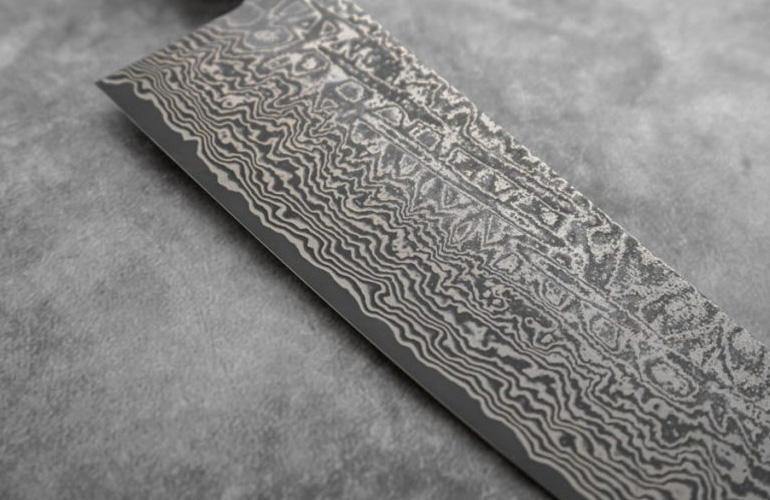
The use of Damascus Steel in kitchen knives can be somewhat of a polarising topic and poses several questions. Is there any real difference in performance between a Damascus Steel kitchen knife and regular steel kitchen knife? Is it all just for looks? Why are some Damascus kitchen knives so damn expensive and some are so cheap? Here we’ll answer these for you, sticking to the facts and giving you the information you need to make an informed decision about whether a Damascus Steel Kitchen knife may be right for you.
Origins/Types
The term ‘Damascus Steel’ can actually refer to several different types of end product, each utilising different methods and materials. Damascus Steel, Wootz Steel, and Pattern Weld all hold some overlap with each other, but all epitomise a product that is the result of multiple steels that have been forged or cast together using different methodologies then etched to bring out a unique layered finish.
The first iteration of what is referred to as the ‘original’ Damascus Steel in first arose in Middle-Eastern sword making, of which the original technique has been lost for may hundreds of years. This Damascus Steel weaponry was the result of forging Wootz steel, produced in India and traded to the Middle East. Tales of the stunning beauty, strength, and sharpness of the weapons produced spread throughout the world, but the process for making Wootz, the critical component of Damascus Steel, was lost in the 1700’s, and with it, there went the original iteration of Damascus Steel itself. It’s original form has never been replicated, even after the efforts of modern day science.
This presents the argument that any kitchen knife currently available labelled ‘Damascus Steel’ is technically misleading, as all ‘Damascus Steel’ at present time is the result of Pattern Welding several different alloys together which are then forged and re-welded then ‘etched’ with chemicals to produce a Damascus-like pattern. This etching process eats away a particular steel in the blade, leaving the other steel(s) untouched. This process is subject to much experimentation by pattern weld Damascus Steel makers around the world and through arranging the varying steels in specific ways, incredibly complex shapes can be produced on the blade of the knife.
Materials Used
So what is modern day Damascus Steel made from?
The truth is, just about any combination of stainless or alternating high or low carbon steel can be used, in combination with nickel alloys and even in some cases, items like scrap metal, screws, and bolts.
The arrangement of these steels is sketched out and planned as to ascertain the final appearance and then welded together, forged and drawn out, then folded or cut and the process is repeated to attain as many layers as desired.
While these pattern weld Damascus steels are similar in appearance to the first Damascus Steels produced, their internal composition is entirely different.
Some types of modern-day Damascus steel are manufactured by layering stainless steel, resulting in a more subtle pattern. This layered stainless is then ‘clad’ onto a core of harder, more wear-resistant higher carbon steel.
Damascus Steel Kitchen Knives produced using this technique are more expensive, as the time required produces a blade of far superior quality that is durable, but also looks fantastic.
This is a process that has been favoured more and more by Japanese Bladesmiths in recent times due to its fantastic edge retention from the hardness of the inner core, and also the durability due to the layers of more flexible and stain resistant stainless steel on the outside.
Which brings me to the question, “Is Damascus steel better than modern day steel? In terms of strength, and durability, there are modern exotic alloys that can far outperform pattern weld Damascus Steel.
Often, the core cutting edge of a knife is made from high carbon steel and clad with Damascus steel, such as the Yoshimi Kato SG2 Gyuto. It’s core is an exotic alloy, SG2 Powder Steel, and the cladding is alternating layers of stainless steel with added nickel, resulting in the Damascus steel appearance.
But that doesn’t mean that a well made Damascus Steel kitchen knife is of any less use to a professional chef or home cook than a non-Damascus Steel one.
The true appeal of Damascus Steel lies in its unique and exotic patterned finishes, and whether or not they look better than non-Damascus Kitchen knives is entirely subjective.
Just like anything, you get what you pay for. Damascus Steel made the right way requires an extraordinary level of attention to detail, experience, and precision, and it all comes at a price.
If it’s cheap, it ain’t good, and if it’s good, it ain’t cheap.
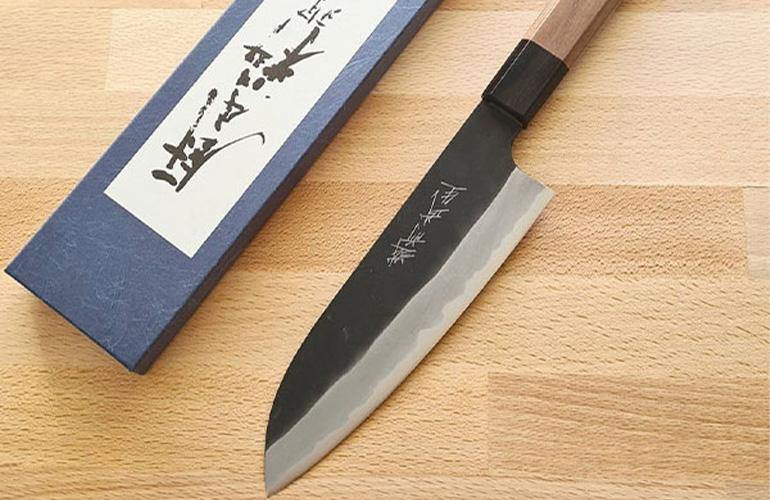
Whether you’re a home cook, amateur chef or a professional, we all need a good set of knives in the kitchen.
For many chefs it’s what defines them, and a Japanese chef knife arguably is as good as it gets. Working with the right blade will ensure superior precision and maintain the integrity of the ingredients you’re working with.
Japanese chef knives are becoming increasingly popular with Western chefs, and it’s not surprising given their rich history and reputation for quality, sharpness and overall precision craftsmanship.
At Chefs Edge we specialise in high performance Japanese kitchen knives crafted by some of Japan’s most talented blacksmiths. We only pursue kitchen knives of the highest quality and the finest craftsmanship, and provide them to you at the best possible price, while striving to deliver the best customer service possible.
If you’re considering Japanese chef knives for your kitchen, it’s important to first understand the different kinds, to help you decide what’s right for you. The types of kitchen knives you need will ultimately depend on your level and style of cooking, and the techniques you’ll demand from your knife.
Gyuto
If you’ve never owned a Japanese kitchen knife before, the Gyuto meaning ‘beef knife’ is the most versatile choice to start your collection and obsession! One of the most commonly used knives in the kitchen, the Gyuto can cover a majority of kitchen tasks.
It’s similar to a classic Western style chef’s knife, except that it’s typically lighter and thinner. The Gytuo is typically anywhere between 18cm-27cm in length, depending on the required task. It has a long curve from heel to point and is ideal for rocking-cuts and precision work like mincing, fine preparation of vegetables and slicing meat.
Shop our range of Gyuto’s here
Santoku
If you’re looking for another good all-rounder, a Santoku knife is your next best choice after the Gyuto. This smaller multipurpose knife has a flatter blade profile that the Gyuto, and is great for dicing and chopping vegetables, fish and meat.
The broader blade also helps to scoop ingredients off the board with ease. The Santoku can range from 13cm to 18cm in length, and has a slightly flatter cutting edge than the Gyuto.
Shop our range of Santoku’s here
Bunka
A versatile blend of the Santoku, Gyuto, and Nakiri, the Bunka is a smaller and thinner than the Gyuto and Santoku, with a much higher taller blade, and a ‘K-tip’ which allows more specialised cutting tasks.
This general purpose knife is also ideal for push cutting and chopping vegetables, and can handle delicate work like trimming and paring with ease. (Plus, they look absolutely fantastic, our favourite blade shape by far!)
Shop our range of Bunka’s here
Deba
For Western Chef’s the Deba is the ultimate butcher’s knife alongside the trusty meat cleaver. Although the Deba is traditionally known for its uses in filleting fish, its structure merits its use for cutting through joints of meat and poultry.
You’ll notice that an authentic Japanese Deba will have a single bevel edge, while the Western version has a double bevel edge, which is why it’s also ideal in meat preparation.
The Deba has a thick spine, and is usually heavier than it’s Gyuto/Santoku counterparts. This extra weight helps make light work of more heavy duty cutting tasks.
Nakiri
As its meaning suggests, the Nakiri knife is a vegetable knife. Crafted with a straight double edged blade and no tip, it’s perfect for chopping and dicing.
You’ll find this knife to be everyone’s ‘go to’ in most Japanese homes. The flatter blade profile allows more of the cutting edge to be in contact with the board.
Shop our range of Nakiri’s here
Petty
The Japanese version of a French petit knife, the Petty knife is the quintessential paring and utility knife.
It’s nimble and perfect for small handheld tasks that the Gyuto or Santoku is too large for, such as peeling and cutting small fruit, vegetables and herbs. The small length of the blade makes sharpening a breeze compared to other types of knives.
Shop our range of Petty’s here
Yanagiba
The original sushi knife! Traditionally used to cut sashimi, but these days can also be used to cut meat. This is a long, thin blade up to ~37cm in length, and is a single bevel, chisel ground edge. This ensures the meat falls off to one side and repeated cuts can be made to large pieces of meat in quick succession with excellent repeatability.
Other types of Japanese kitchen knives
Chukabocho – the Japanese version of a cleaver, it is large and rectangular in shape and great for preparing large veggies such as cabbage. The thin blade also means it can handle delicate tasks like trimming and mincing herbs. This cleaver is not designed to be used as a meat cleaver.
Pankiri – a serrated bread knife, only used for slicing bread and baked goods.
Usuba – a vegetable knife with a Kataba blade. This knife is a little more difficult to use than a Nakiri, but its shape and sharpness ensures a clean and crisp cut every time.
Whether it’s slicing and dicing, chopping or carving, you’ll find the perfect workhorse in the kitchen with a Japanese kitchen knife. If you need help deciding on what knife will best suit your needs, get in touch with the team at Chefs Edge. Once you’ve got your hands on a Japanese kitchen knife you’ll never look back!

Why Japanese Knives Australia?
Take a dive into the wonderful world of Japanese chef knives, and why they’re considered to be the best in the world.
There is a certain romanticism associated with fine goods that are crafted by hand. Japanese chef knives are forged with precision and care, steeped in tradition, and hold quality of the finished product above all else. They hold a special place in the hearts of many.
Deep down we yearn to own something special, something that has been meticulously designed and constructed, not stamped out on an assembly line.
Yes, they can be pricey, the price reflects the caliber of the build. A high-quality knife, with the correct care, will remain are the forefront of your kitchenware for years. Not only do they make light work of dicing onions, Japanese kitchen knives have numerous design features that make them outperform almost all other kitchen knives in the world.
So what makes Japanese kitchen knives so special?
Weight
Generally speaking European knives are heavy; this is due to the ‘full tang’ design feature. The steel of full tang blades continue through to the end of the handle, as pictured below.
In some instances, the handle is also made of steel resulting in a knife which is overly heavy and cumbersome to use for long periods of time. As seen in the image below (courtesy of www.thespruceeats.com), all that extra steel in the handle adds much to the weight of the knife.
The steel of a Japanese blade quickly tapers off in size after it enters the handle reducing the overall weight of the knife. This may bring the balance of the knife to be slightly forward heavy, a trait many chefs quickly get used to in order to take advantage of the Japanese chef knives superior performance. This image below shows an average Japanese chef knife in terms of the steel quickly dropping off as it gets into the handle.
Some Japanese chef knives may feature what is called a ‘distal taper’, where the thickness of the blade increases just before it enters the handle, adding weight to the rear of the knife to bring it back into balance. This increases comfort to the user making it perfect for all day every day use.
Grind/Bevel
The ‘grind’ or ‘bevel’ refers to the shape of the blade when you look down from the handle to the tip. On the whole, European knives have a thicker, heavier blade and the cutting edge itself is a short ~ 20-degree taper that is even on both sides (50/50), about 1-2mm from the tip of the blade.
The Japanese blade will be much thinner, and the thinner the blade, the easier cuts are made, and the more agile cutting work it can perform. The cutting edge of a regular Japanese knife is much lower than 20 degrees and starts much higher on the blade. Traditional Sashimi knives like the Yanagiba or the Sujuhiki (knives designed for long pull cuts) have only a single bevel, meaning that one side is flat, and the other side tapers off at a low angle. This pushes the food away from the blade once the cut has been made.
A thinner grind, although resulting in much greater sharpness, means that a Japanese kitchen knife may be prone to chipping or breakage if used improperly (torquing/twisting the blade while cutting, or hitting or chopping hard or frozen objects). Whilst European knives can be more robust, they are made of softer steel, go blunt quicker, and can’t make as precise cuts.
For most chefs, the trade-off for much better all-round performance is worth the small level of extra care and maintenance required of Japanese kitchen knives.
Exotic Steels
While many European knives will be made from some form of softer stainless steel, most Japanese knives employ the use of high-carbon steel combined with extra elements (nickel, chromium, vanadium, tungsten, molybdenum) to produce exotic alloys that have greatly enhanced corrosion resistance, hardness, and durability.
A Japanese traditional high-carbon steel such as Aogami Super (Blue Paper Steel) or Shirogami Steel (White Paper Steel) will not have the corrosion resistance of their stainless counterparts, and as such will need extra care and maintenance and can be reactive to certain foods, developing a multicoloured hue on the blade known as a ‘patina’.
It is common for Japanese knives to be crafted with a technique called ‘San-Mai’, by which a very hard cutting edge of reactive, high-carbon steel is sandwiched between 2 external layers of softer stainless steel. This guarantees fantastic cutting performance and an easy to maintain blade.
Hardness
Steel hardness can be graded by the Rockwell hardness scale. Softer steels such as Cromova can only be hardened to 54-56 which is considered quite low. These knives can take more punishment, and are less brittle, but will go blunt extremely quickly due to their softness.
Japanese knives are normally anywhere between 61-67 HRC, giving them their legendary edge retention and long lasting sharpness. This comes at a price, however, with extreme hardness comes the risk of chipping and damaging the blade from improper use as described above.
Tradition and Care
The Japanese consistently strive towards excellence in their craft, as is the age-old philosophy so widespread in Japanese culture. Individual Blacksmiths will always be creatively exploring ways to refine their processes and push the boundaries of what is possible in knifemaking, whilst preserving the traditions that have been passed on throughout generations.
Their aim is to ensure that every blade is as carefully and meticulously crafted to the same quality as the last and that the lust for Japanese kitchen knives, the finest in the world, continues for many more generations to come.
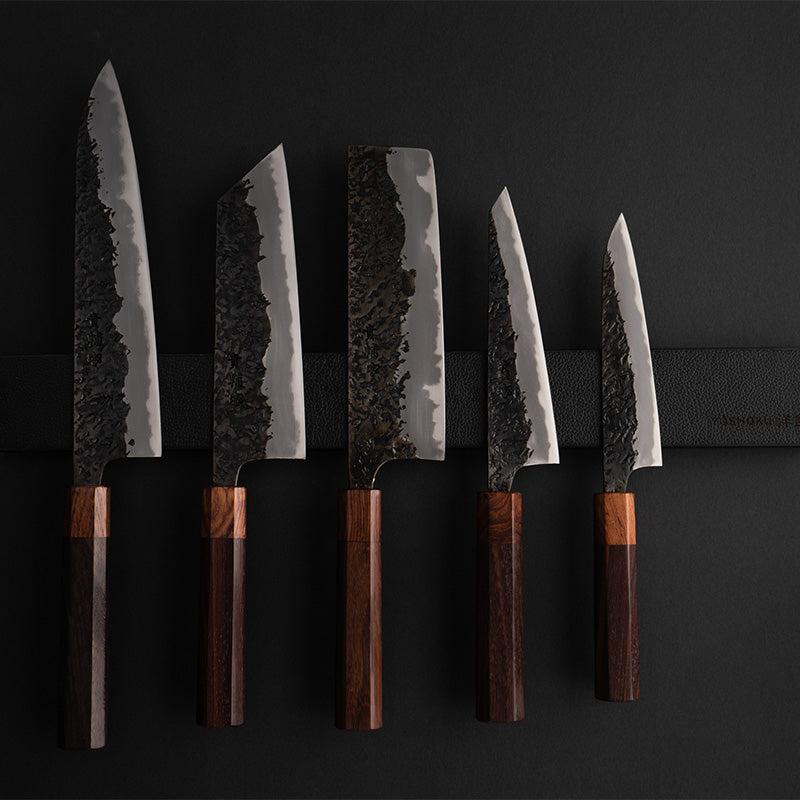
A Guide to Japanese Knives (2021)
A Guide to Japanese Knives
In the culinary world, Japanese knives are highly praised. We're here to tell you that they truly live up to the hype. Japanese knives are the product of a rich culture. Skilled artisans use the finest materials and techniques to make these high-quality tools. Many varieties are available that serve different purposes in the kitchen.
Looking to add Japanese knives to your arsenal? We don't blame you. These tools make a great addition to your kitchen. They also go a long way in helping you prepare authentic cuisine.
Not sure how to find the right Japanese knife in Australia? You're not alone. It can be tricky when you're not familiar with these traditional tools. Luckily, we're here to help!
Here's a complete guide to Japanese knives. We'll go over different materials, varieties, and more to help you become an informed buyer.
Western vs. Japanese Knives
Before diving in, it's worth mentioning the main differences between Western and Japanese knives.
Material Quality
Western knives are easier to care for. They aren't as brittle and won't rust as easily. Their Japanese counterparts require more care as they are more brittle and prone to rust. However, they tend to be sharper and hold their edge longer.
Blade Shape
Traditional Japanese knives have a single-bevelled blade, where one side is sharpened, and the other side is completely flat. A chef uses this blade to make precise diagonal cuts. Note that because just one side of the blade is sharpened, a single-bevelled knife is made for right-handed chefs. If you are left-handed, you will have to get a specialty leftie knife (which can be more expensive).
Western knives, on the other hand, usually have double-bevelled blades. They are sharpened on both sides, resulting in a V-shaped blade edge. Though easier to sharpen, this blade isn't as good for high-precision cuts. But, you'll be glad to hear that double-bevelled blades are ambidextrous by design. Both left- and right-handed chefs can use them with ease.
Know the Different Materials
Now, let's take a look at the different materials Japanese knives are made out of.
Carbon Steel
Relatively speaking, carbon steel is sharper and less resistant to wear. When it does become dull, it's easier to sharpen.
Carbon steel is also more brittle and prone to rust. Professional chefs are more likely to own carbon steel knives to keep up with the required maintenance.
Stainless Steel
Compared to carbon steel, stainless steel isn't as sharp. As a result, it is prone to wear and slightly more difficult to sharpen.
Stainless steel, however, has many perks. It is easier to care for as it isn't as brittle or prone to rust. This makes it a popular choice among amateur chefs.
Different grades of stainless steel knives (VG-10, 10A, or AUS-10, etc.) offer unique hardness and edge retention levels.
Damascus Steel
Traditional Damascus steel is no longer made. Modern manufacturers, however, attempt to replicate the historical material.
Damascus steel knives can be made out of either carbon or stainless steel. Their key feature is their beautiful water-like patterns. Many chefs prefer knives made out of this material for aesthetic reasons.
If you are buying a Japanese knife in Australia, consider whether you want a carbon or stainless steel knife. Then, decide if you want a standard design or a beautiful Damascus pattern.
Find the Right Japanese Knife in Australia
The type of material you choose is important. However, you'll also want to find a knife of the right size and shape for what you'll be using it for.
Here are some of the most popular types of Japanese knives:
Gyuto
A Gyuto is not necessarily a traditional Japanese knife. It is a Japanese adaptation of the Western chef's knife.
A Gyuto has a curved blade, tall heel, and pointed tip. Its blade is usually around 210-270mm in length. While chefs use it for various applications, a Gyuto is particularly useful for piercing and rocking motions.
Garasuki
A Garasuki is another Japanese adaptation. It mimics a Western boning knife.
The triangular blade is tough and has a sharp tip. While not good for cutting through bones, it is great for maneuvering around tight spaces. Chefs often use it to break down poultry and red meat.
Honesuki
A Honesuki is essentially a smaller version of a Garasuki.
Santoku
A Santoku (along with the rest of the knives we'll be discussing) is a traditional Japanese knife.
A Santoku is similar to a Gyuto in that it is all-purpose. The name, translating to “three virtues,” refers to its ability to cut meat, fish, and vegetables. With a Santoku, chefs tend to use an up-and-down motion rather than a rocking motion.
Nakiri
A Nakiri is for cutting, slicing, and peeling vegetables. The double-bevelled blade, which can be between 240-300mm, is thin and straight.
Usuba
An Usuba is the single-bevelled version of a Nakiri. Its blade is much thinner, making it perfect for decorative cuts and paper-thin slices.
Takohiki
Chefs use a Takohiki to slice raw fish for sashimi. The blade is rectangular.
Yanagiba
A Yanagiba is also used to slice raw fish for sashimi. The blade, however, is slim, long, and has a curved tip.
Deba
A Deba is for breaking down fish. The chunky blade can cut through bones, descale, etc. A standard size Deba (Hondeba) has a blade length of 210mm.
Unagisaki
A Unagisaki is for preparing Unagi. The sharp tip can pierce through the slippery eel's skin and filet the fish.
Menkiri
Chefs use a Menkiri to cut through soba noodles and udon. A Menkiri is heavy, has a straight edge, and features a blade that extends to the handle.
Buy Your Japanese Knife in Australia
With the help of this guide, you should find the perfect Japanese knife in Australia. Just keep in mind that these knives are crafted with care, and you'll need to keep them in pristine condition if you want to get your money's worth.
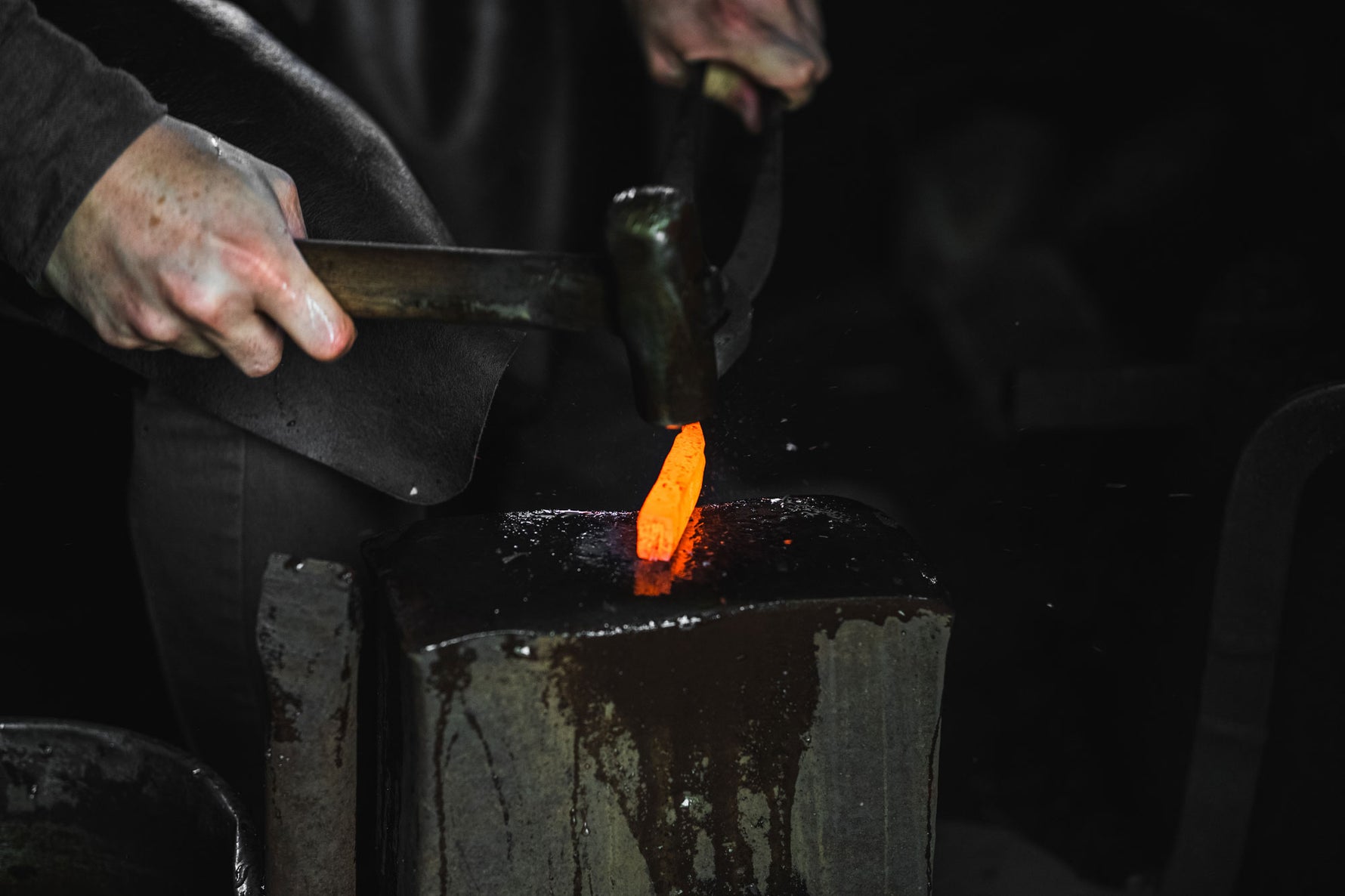
How to Make a Japanese Knife
Many people have a deep and entirely justifiable fascination with Japanese knives. Sharpness is part of the intrigue: learn more about the history of tameshigiri, if you want proof of the power of these blades.
There's also a fascinating background of how Japanese knives are made. A certain part of the forging process can only be performed after dark so that the blacksmith can better judge what color the metal is glowing — you've got to admit that's unique.
But aside from intrigue, people love the quality of these knives, thanks to how they're made. Here, we look at the process that Japanese knives are put through to obtain that incredible quality. Let's start with a breakdown of how they differ from Western knives.
What's the Difference Between Japanese Knives and Western Knives?
There are a few major differences between many Japanese knives and Western knives:
Single bevel (Japanese) vs. double bevel (Western): the single bevel means that a blade is better suited to one hand than the other and can hold a sharper edge for more delicate cuts
Harder, more brittle steel: Japanese knives tend to be made of harder steel. This is more brittle but holds an edge for longer if treated with respect.
Single-piece vs. composite handle: Western knives tend to have a handle made of two pieces of wood riveted together around the tang. In Japan, the tang is traditionally knocked into a single block of wood.
So, it's clear Western and Japanese knives are very different, but how are these blades made? There are numerous production modes, but we'll just look at two: the high-quality factory method and the mysterious, romantic hand-forged method.
How to Make a Japanese Knife in the Factory
Rest assured that this isn't your typical ‘factory-made’ knife. There may be a team of workers and machinery, but the care that goes into forging these knives is still exquisite. It starts, of course, with the metal.
Step 1: Initial Shaping
Blanks of metal are heated in a forge and then pounded out with a power hammer. The metal is then periodically quenched to give it strength. This process leads to the blades taking on their basic form and achieve uniform strength in all parts.
At the end of the shaping, the blades are treated on a sanding belt. The shape of the blades is controlled and carefully monitored by expert craftspeople. As mentioned, this isn't your typical factory.
Step 2: The Kiln
The knives are put into a kiln and then cooled at a controlled pace a day after the initial shaping. The heating and cooling changes the metal's molecular structure to something approaching the desired result — but not quite. There's more work to be done on day 3.
Step 3: The Finished Shape
As the knives aren't yet at the final hardness, the final stage is to make some cold adjustments. This is an intensive, meticulous process done by hand. The knives are given their desired shape and then put through the kiln one more time, which gives them the perfect hardness.
Step 4: Sharpening
Sharpening a knife is a specialized job. The blades are sent to experts who sharpen the blades to an unbelievably fine grade. Even here, the temperature is key: the wheels that sharpen the blades are kept cool with water, as raising the metal to high temperatures would compromise its quality.
The knives produced using this method are sharper and of better quality than what you'll find in many restaurants. Here's what you wanted, though: the handmade method.
How to Make a Japanese Knife by Hand
Step 1: The Furnace
Masters in forging Japanese knives also start by heating metal in a furnace. So far, so familiar. Just like a great chef knows when a steak is perfectly medium-rare by touch, a master blacksmith knows when the metal is hot enough by its color, as well as other signals that the untrained eye just won't notice.
The metal is shaped with an air hammer and the watchful eye of the blacksmith. Precision is the key to perfection here, and not a single blow is wasted.
Step 2: Cold Forging
‘Cold forging’ means that the metal is, well, almost cold. This makes it far harder to work with than hot metal but yields far superior results. If you don't know what you're doing, it's easy to damage the metal by cold forging.
The blacksmith cold forges the knife to make the metal stronger on a molecular level than if it was hot forged. This job is sometimes given to a master craftsman's apprentice, which can seem an odd term for someone who already understands metalworking better than most mortals.
Step 3: Quenching
The blade is heated and then quenched to bring it to a desired level of hardness. Such is the need for perfection that it's important to use the right fuel for the furnace.
Coal, for example, contains a lot of impurities that make it unsuitable for this refined process. Think of your dad's bourbon-soaked hickory wood chips for his beloved barbecue, but on a whole different level.
The blacksmith knows instinctively what color the metal's glow has to be. This is why quenching only takes place after dark.
Step 4: Tempering
The blade must then be tempered to achieve the final, desired hardness. This takes place in carefully controlled temperature conditions and is essential before the blade can be sent off for sharpening.
Step 5: Creating a Legendary Edge
A top-quality, hand-forged knife deserves no less than the best to put an edge on it. A master knife sharpener is known as a togishi. This person's job is to put an edge on the blade that matches the quality of its construction.
A Labor of Love
Japanese knives are works of art in their own right. The care and years of training that go into producing a quality knife are formidable, and this is true of specialized factories and hand-crafted knives.
If you're interested in Japanese knives, something you might want to put on your bucket list is taking a tour of a workshop. Japanese knives also make wonderful gifts, as each one has a story behind it. Let your fascination take you further into this amazing world: ask any ‘apprentice.’ There's always more to learn!
